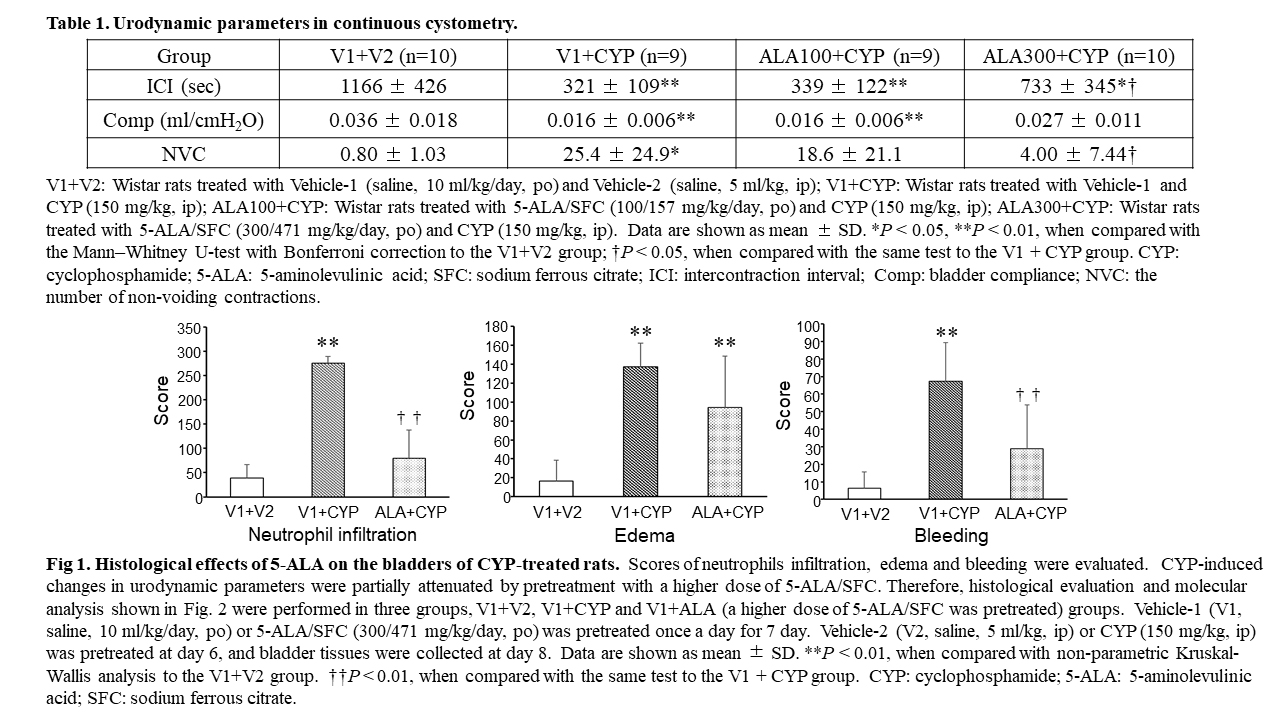Back
Poster, Podium & Video Sessions
Moderated Poster
MP07: Bladder & Urethra: Anatomy, Physiology & Pharmacology
MP07-07: 5-Aminolevulinic acid prevents cyclophosphamide-induced bladder dysfunction in rats
Friday, May 13, 2022
10:30 AM – 11:45 AM
Location: Room 228
Takahira Kuno*, Takahiro Shimizu, Chiaki Kawada, Atsushi Kurabayashi, Zou Suo, Hiroki Mogawa, Masayuki Tsuda, Motoaki Saito, Keiji Inoue, Kochi, Japan
- TK
Takahira Kuno, MD
Kochi University
Poster Presenter(s)
Introduction: Cyclophosphamide (CYP) is one of the most widely used chemotherapeutic agents and causes a serious side effect of hemorrhagic cystitis (HC). 5-Aminolevulinic acid (5-ALA) is a natural amino acid that originally exists in the body. The combination of 5-ALA and sodium ferrous citrate (SFC) improves mitochondrial function and increases the expression level of heme oxygenase-1 (HO-1), a cytoprotective molecule. In this study, we examined effects of 5-ALA and SFC pretreatment on bladder dysfunction in CYP-treated rats.
Methods: Male Wistar rats (340-460 g) were pretreated with vehicle or 5-ALA/SFC (100/157 or 300/471 mg/kg/day, po) once daily for 7 days before cystometry (CMG, saline 4 ml/h). Saline or CYP (150 mg/kg, ip) was administered 2 days before CMG. CMG was performed under urethane anesthesia (0.8 g/kg, ip) via a catheter inserted into the bladder. After CMG, bladder tissues were collected to perform HE staining, ELISA and real-time PCR.
Results: CYP induced a shorter intercontraction interval (ICI), lower bladder compliance (Comp), increased number of non-voiding contractions (NVCs) (Table 1) without changing post void residual volume (data not shown), and increased pathological scores (neutrophil infiltration, bleeding and edema) (Fig. 1) and myeloperoxidase (MPO) expression in the bladder (Fig. 2). Pretreatment with a higher dose of 5-ALA/SFC significantly improved CYP-induced ICI shortening and increases in NVCs and neutrophil infiltration/bleeding scores, and enhanced HO-1 mRNA expression in the bladder (Fig. 2). In addition, CYP-induced decreases in bladder compliance and increases in MPO were not detected in 5-ALA/SFC pretreated rats (Table 1, Fig. 2).
Conclusions: Pretreatment with 5-ALA shows protective effects on bladder dysfunction in CYP-induced HC by improving inflammatory changes in bladder tissues mediated at least by up-regulation of HO-1, suggesting that 5-ALA represents a new candidate as a protective drug for HC, a side effect induced by CYP chemotherapy.
Source of Funding: None


Methods: Male Wistar rats (340-460 g) were pretreated with vehicle or 5-ALA/SFC (100/157 or 300/471 mg/kg/day, po) once daily for 7 days before cystometry (CMG, saline 4 ml/h). Saline or CYP (150 mg/kg, ip) was administered 2 days before CMG. CMG was performed under urethane anesthesia (0.8 g/kg, ip) via a catheter inserted into the bladder. After CMG, bladder tissues were collected to perform HE staining, ELISA and real-time PCR.
Results: CYP induced a shorter intercontraction interval (ICI), lower bladder compliance (Comp), increased number of non-voiding contractions (NVCs) (Table 1) without changing post void residual volume (data not shown), and increased pathological scores (neutrophil infiltration, bleeding and edema) (Fig. 1) and myeloperoxidase (MPO) expression in the bladder (Fig. 2). Pretreatment with a higher dose of 5-ALA/SFC significantly improved CYP-induced ICI shortening and increases in NVCs and neutrophil infiltration/bleeding scores, and enhanced HO-1 mRNA expression in the bladder (Fig. 2). In addition, CYP-induced decreases in bladder compliance and increases in MPO were not detected in 5-ALA/SFC pretreated rats (Table 1, Fig. 2).
Conclusions: Pretreatment with 5-ALA shows protective effects on bladder dysfunction in CYP-induced HC by improving inflammatory changes in bladder tissues mediated at least by up-regulation of HO-1, suggesting that 5-ALA represents a new candidate as a protective drug for HC, a side effect induced by CYP chemotherapy.
Source of Funding: None



.jpg)
.jpg)